Dancing Aurora |
||||||||||||||||
 |
 |
|||||||||||||||
Knitted jumper in DROPS Air and DROPS Big Delight. Piece is knitted top down in two coloured English rib with raglan. Size: S - XXXL
DROPS 218-26 |
||||||||||||||||
|
------------------------------------------------------- EXPLANATION FOR THE PATTERN: ------------------------------------------------------- PATTERN: See diagram A.1. All uneven rounds are worked with Big Delight. All even rounds are worked with Air (see diagram). INCREASE FOR RAGLAN: Increase for raglan on each side of purl stitches with marker (= raglan stitches), i.e. Increase in knit stitch and yarn over closes raglan stitch. Increase 2 stitches on each side of raglan stitches (= 16 stitches increased on increase round): All increases are done on a round where yarn over and knit stitch are knitted together (= a round with Air). Increase 2 stitches in knit stitch and yarn over by working 3 stitches in stitch and yarn over follows: Knit stitch and yarn over together but wait to pass stitch and yarn over off left needle, make 1 yarn over on right needle, knit same stitch and yarn over together one more time, then slip knit stitch and yarn over worked off left needle (= 2 stitches increased). Then work the new stitches in English rib (A.1) but note that on first round after increases, purl purl stitches in increase without working together with yarn over because yarn over is not made. DECREASE TIP (applies to mid under sleeves): Decrease under sleeves on each side of 3 stitches mid under sleeve (= 1 purl stitch + 1 English rib stitch (= stitch with marker) + 1 purl stitch). All decreases are done on a round where yarn over and knit stitch are knitted together (= a round worked with Air). DECREASE 2 STITCHES TOWARDS THE LEFT AS FOLLOWS (i.e. begin right after first purl stitch after stitch with marker): Slip first knit stitch and yarn over on to right needle knitwise, knit the next 2 stitches together (i.e. 1 purl + knit stitch and yarn over), then slip the loose stitch and yarn over over stitches worked together (= 2 stitches decreased). DECREASE 2 STITCHES TOWARDS THE RIGHT AS FOLLOWS (i.e. begin 4 stitches + 2 yarn overs before stitch with marker): Slip first knit stitch and yarn over loosely on to right needle knitwise, purl 1, pass slipped stitch and yarn over over purl stitch, slip stitch back on left needle, pass slipped stitch and yarn over closest to purl stitch over stitch place back on left needle, slip the remaining stitch over on to right needle (= 2 stitches decreased). CAST-OFF TIP: To avoid a tight cast-off edge you may use a larger needle size. If this also is too tight, work a 1 yarn over after approx. every 4th stitch while casting off (cast off yarn overs as regular stitches). ------------------------------------------------------- START THE PIECE HERE: ------------------------------------------------------- JUMPER - SHORT OVERVIEW OF THE PIECE: Neck edge and yoke are worked in the round on circular needle, top down. Now divide yoke for body and sleeves. Body is worked in the round on circular needle, top down. Work sleeves in the round on double pointed needles/short circular needle, top down. Work yoke, body and sleeves in two-coloured English rib with Air visible on right side and Big Delight visible on wrong side. Work neck edge and rib at the bottom of sleeves and body with Air. NOTE! All numbers of given when working English rib is without yarn overs because yarn overs are counted as 1 stitch together with slipped stitch. NECK EDGE: Cast on 78-82-86-88-96-100 stitches on a short circular needle size 4 mm with 1 strand Air. Rounds begin mid back. Knit 1 round. Then work rib in the round (= knit 1/purl 1) for 8 cm. Knit 1 round while decreasing 2-2-6-4-0-0 stitches evenly = 76-80-80-84-96-100 stitches. Insert 1 marker in middle of round. Then work yoke as explained below. Measure yoke from marker. YOKE: Switch to circular needle size 5 mm and knit 1 round. Work next round as follows: * Knit 1, make 1 yarn over, slip 1 stitch purlwise *, work from *-* the entire round. Now insert 4 markers in piece as explained below (this is done without working the stitches). Use markers when increasing for raglan. Count 13-15-15-15-17-17 stitches (= half back piece), insert 1 marker in next stitch (= raglan stitch), count 9-9-9-9-13-13 stitches (= sleeve), insert 1 marker in next stitch (= raglan stitch), count 27-29-29-31-33-35 stitches (= front piece), insert 1 marker in next stitch (= raglan stitch), count 9-9-9-9-13-13 stitches (= sleeve), insert 1 marker in next stitch (= raglan stitch). 14-14-14-16-16-18 stitches remain on back piece after last marker. Then work A.1 in the round, every other round with Air/Big Delight. AT THE SAME TIME increase for RAGLAN as explained below. REMEMBER THE KNITTING TENSION! RAGLAN: When 7 rounds of A.1 have been worked in total (and next round begins with “knit yarn over and slipped stitch together” and worked with Air), increase for RAGLAN – read explanation above (= 16 stitches increased on increase round). Increase like this every 8th round (i.e. every 4th round with visible English rib stitches vertically) 7-8-9-10-11-12 times in total vertically = 188-208-224-244-272-292 stitches on needle. Continue A.1 in the round without increases until piece measures 18-20-22-24-26-28 cm from marker by the neck (piece measures approx. 22-24-26-28-30-32 cm from shoulder). Now divide yoke for body and sleeves. I.e. work next round as follows from mid back: Work 27-31-33-35-39-43 stitches as before (= half back piece), slip the next 39-43-45-51-57-59 stitches on 1 stitch holder for sleeve, cast on 9 new stitches on row (= in the side under sleeve), work 55-61-67-71-79-87 stitches as before (= front piece), slip the next 39-43-45-51-57-59 stitches on 1 stitch holder for sleeve, cast on 9 new stitches on needle (= in the side under sleeve) and work the 28-30-34-36-40-44 stitches as before (= half back piece). Finish body and sleeves separately. NOW MEASURE PIECE FROM HERE! BODY: = 128-140-152-160-176-192 stitches. Continue A.1 in the round as before. Work until piece measures 30 cm from division in all sizes (approx. 4 cm remain until finished measurements, try the jumper on and work to desired length). Switch to circular needle size 4 mm and work with Air until finished measurements. Work rib in the round (= knit 1/purl 1) - on first round knit yarn overs together with knit stitches. When rib measures 4 cm, loosely cast off with knit over knit and purl over purl - read CAST-OFF TIP! Jumper measures approx. 56-58-60-62-64-66 cm from shoulder and down. SLEEVE: Slip the 39-43-45-51-57-59 stitches from stitch holder in one side of piece on double pointed needles or a small circular needle size 5 mm, and cast on 9 new stitches mid under sleeve = 48-52-54-60-66-68 stitches. Insert 1 marker in the middle of the 9 stitches that were cast on under sleeve. Move the marker upwards when working; it should be used for decrease mid under sleeve. Work A.1 in the round and make sure to begin on correct round in pattern so that round with Air is most visible from right side the same way as on yoke. AT THE SAME TIME ON 8th round (i.e. on 4th visible round with English rib vertically), decrease 4 stitches mid under sleeve - read DECREASE TIP (decrease 2 stitches towards the left after stitch with marker, and decrease 2 stitches towards the right before stitch with marker). Decrease like this every 8th-8th-8th-8th-6th-6th round (i.e. every 4th-4th-4th-4th-3rd-3rd round with visible English rib stitches vertically) 3-3-3-4-4-4 times in total vertically = 36-40-42-44-50-52 stitches. Work until sleeve measures 41-39-37-36-34-32 cm from division (approx. 4 cm remain until finished measurements, try the jumper on and work to desired length). Switch to double pointed needles size 4 mm and work with Air until finished measurements. Work rib in the round (= knit 1/purl 1) - on first round knit yarn overs together with knit stitches. When rib measures 4 cm, cast off with knit over knit and purl over purl - remember CAST-OFF TIP! Sleeve measures approx. 45-43-41-40-38-36 cm from division. Work the other sleeve the same way. ASSEMBLY: Sew the opening under the sleeves. |
||||||||||||||||
Diagram explanations |
||||||||||||||||
|
||||||||||||||||
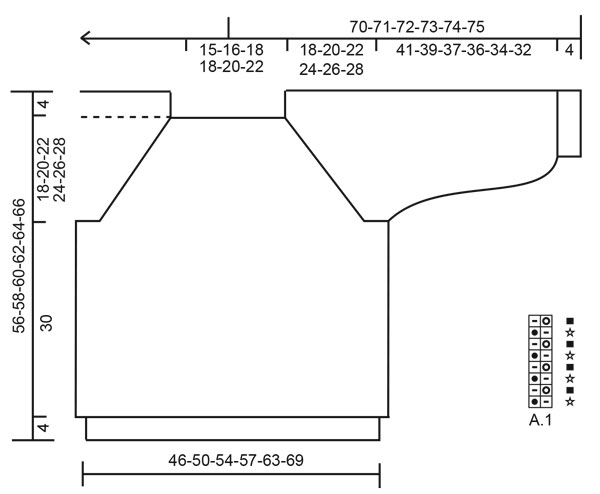
|
||||||||||||||||
|
Have you made this or any other of our designs? Tag your pictures in social media with #dropsdesign so we can see them! Do you need help with this pattern?You'll find tutorial videos, a Comments/Questions area and more by visiting the pattern on garnstudio.com. © 1982-2024 DROPS Design A/S. We reserve all rights. This document, including all its sub-sections, has copyrights. Read more about what you can do with our patterns at the bottom of each pattern on our site. |
||||||||||||||||







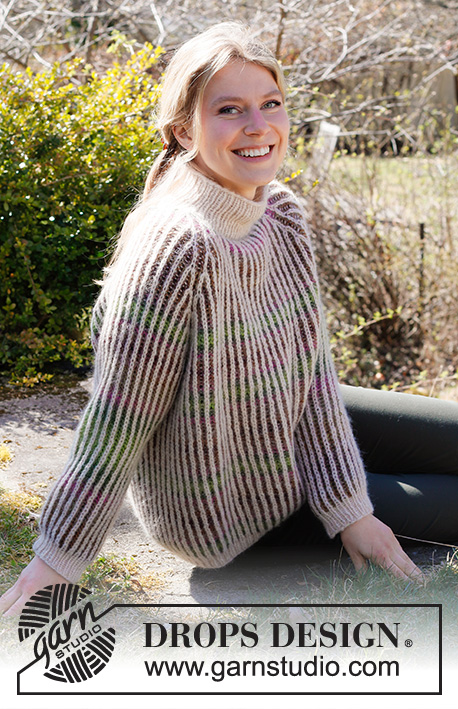

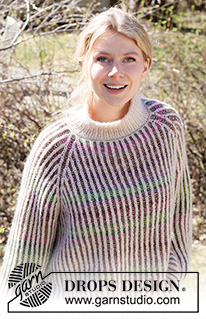














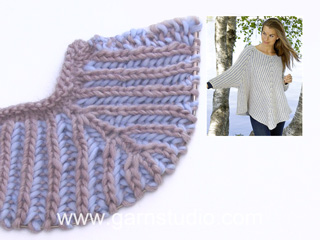
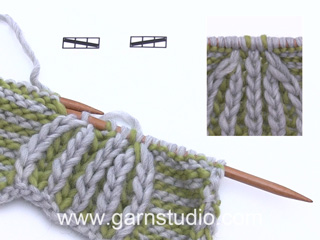









































Comments / Questions (37)
Hej, när man ökar för raglan stickar man två räta maskor med ett omskag i mellan, i samma räta maska. Nästkommande varv står det att man ska sticka ” avigmaskorna i ökningen aviga”?? Dem är ju stickade räta! Ska de alltså stickas räta då?
05.02.2024 - 18:46DROPS Design answered:
Hei Carola. Når du øker strikker du 1 rett - 1 kast-1 rett i en og samme maske. Videre står det i oppskriften at de nye maskene strikkes i helpatent, altså de økte maskene blir til 1 rett - 1 vrang (kastet) - 1 rett. Så på første omgang etter en omgang med økninger, strikkes vrangmaskene (kastene) i økningen vrang uten å strikkes sammen med kast fordi kastet ikke er lagd. mvh DROPS Design
15.02.2024 - 10:08Wo finde ich das Diagramm ?
09.12.2023 - 16:28DROPS Design answered:
Hallo Marita, das Diagramm finden Sie rechts unter dem Ärmel. Viel Spaß beim Stricken!
09.12.2023 - 19:16Are the gauge and dimensions given with the brioche stitch stretched out and blocked? Or does the final product retain the stretchy accordion texture?
26.11.2023 - 19:24DROPS Design answered:
Dear Ruth, the gauges are for the stocking stitch and English rib while working the garment. The final product is stretchy, due to the English rib. The measurements in the pattern and schematic are for the non-blocked product. Happy knitting!
27.11.2023 - 00:05Ik heb opgemerkt dat dit model identiek is aan drops 213-33 en bij vergelijking vastgesteld dat de uitleg bij het opnemen van de extra steken onder de mouw en op de mouw anders is. Dat geldt ook voor de uitleg van de minderingen op de mouw. Zoals die in drops 213-33 beschreven wordt zou ik al de problemen daarmee in drops 218-26 niet hebben gehad. Waarom zijn er zulke verschillen in 2 volledig identieke truien qua aantal steken, naalddikte?
07.03.2023 - 16:28DROPS Design answered:
Dag Mieke,
De truien lijken inderdaad heel erg op elkaar, maar toch zijn er kleine verschillen, zo neem je in de ene trui minder steken op onder de mouw (oksel) en moet er rekening gehouden worden met het breien in meer kleuren.
08.03.2023 - 12:19Ik probeer tevergeefs op facebook mijn vraag te stellen in de drops workshop. Ivm drops 218-26. Waarom wordt mijn bericht wel eerst gepubliceerd en daarna onmiddellijk verwijderd?
03.03.2023 - 10:06DROPS Design answered:
Dag Mieke,
Om eerlijk te zijn weet ik niet precies wat er gebeurd is op facebook. Je kunt het beste je vraag bij het betreffende patroon plaatsen op onze site.
08.03.2023 - 13:02Ik heb echt problemen om de steken van de mouwen op te nemen en tegelijk 9 extra st op te nemen en dan nog in patroon te breien. Neem je die steken in 1 keer alle 9 op of doe je eerst de helft, daarna de st van de mouw, en dan de andere helft van de 9 st? Om die 9 st in patent te breien, moet je dan met drops air ook meteen omslagen voorzien bij het opnemen ervan? Zelf heb ik gewoon de 9 steken van het lijf gebruikt om de 9 st van de mouw te creëren. Ik vraag dus om wat meer details . Dank
03.03.2023 - 10:01DROPS Design answered:
Dag Mieke,
Je kunt inderdaad de steken opnemen zoals je normaal ook zou doen. Je hoeft er niet perse gelijk omslagen bij te maken. Dat doe je wel in een van de volgende naalden.
08.03.2023 - 13:06Ik heb echt problemen om de steken van de mouwen op te nemen en tegelijk 9 extra st op te nemen en dan nog in patroon te breien. Neem je die steken in 1 keer alle 9 op of doe je eerst de helft, daarna de st van de mouw, en dan de andere helft van de 9 st? Om die 9 st in patent te breien, moet je dan met drops air ook meteen omslagen voorzien bij het opnemen ervan? Zelf heb ik gewoon de 9 steken van het lijf gebruikt om de 9 st van de mouw te creëren. Ik vraag dus om wat meer details . Dank
03.03.2023 - 09:20Buongiorno. Nel mio maglione le coste sembrano diagonali, sbaglio qualcosa?
20.02.2023 - 13:24DROPS Design answered:
Buonasera Esmeralda, se ha seguito le istruzioni riportate, la lavorazione delle coste è corretta. Buon lavoro!
20.02.2023 - 23:47Buongiorno. Nel mio maglione le coste sembrano diagonali, sbaglio qualcosa?
20.02.2023 - 11:31DROPS Design answered:
Buonasera Esmeralda, se ha seguito le istruzioni riportate, la lavorazione delle coste è corretta. Buon lavoro!
20.02.2023 - 23:46Bonjour, Au moment de commencer A1, après le tour des marqueurs à la fin du col, dois-je tricoter en Air ou en Big Delight s'il vous plaît ? J'ai essayé 2 fois en Big delight mais le motif n'est pas celui de la photo. Merci beaucoup !
02.10.2022 - 17:50DROPS Design answered:
Bonjour Mme Ambro, le 1er rang de A.1 doit se tricoter en Big Delight (dans cette vidéo), c'est l'équivalent du fil rose, ainsi vous allez glisser 1 m à l'env, 1 jeté (en big delight) et tricoter la maille suivante et son jeté ensemble à l'envers (en big delight), au 2ème tour de A.1, tricotez en Air (tric. ens à l'endroit le jeté et la maille glissée, faites 1 jeté, glissez la m à l'envers (celle tricotée ensemble à l'envers avec son jeté en big delight)) et continuez ainsi. Bon tricot!
03.10.2022 - 09:41